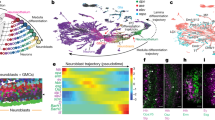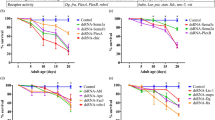Abstract
In Drosophila melanogaster, the axons of retinal photoreceptor cells extend to the first optic ganglion, the lamina, forming a topographic representation. Here we show that DWnt4, a secreted protein of the Wnt family, is the ventral cue for the lamina. In DWnt4 mutants, ventral retinal axons misprojected to the dorsal lamina. DWnt4 was normally expressed in the ventral half of the developing lamina and DWnt4 protein was detected along ventral retinal axons. Dfrizzled2 and dishevelled, respectively, encode a receptor and a signaling molecule required for Wnt signaling. Mutations in both genes caused DWnt4-like defects, and both genes were autonomously required in the retina, suggesting a direct role of DWnt4 in retinal axon guidance. In contrast, iroquois homeobox genes are the dorsal cues for the retina. Dorsal axons accumulated DWnt4 and misprojected to the ventral lamina in iroquois mutants; the phenotype was suppressed in iroquois Dfrizzled2 mutants, suggesting that iroquois may attenuate the competence of Dfrizzled2 to respond to DWnt4.
Note: The PDF version of this article was corrected on 05 January 2006. Please see the PDF for details.
This is a preview of subscription content, access via your institution
Access options
Subscribe to this journal
Receive 12 print issues and online access
$209.00 per year
only $17.42 per issue
Buy this article
- Purchase on Springer Link
- Instant access to full article PDF
Prices may be subject to local taxes which are calculated during checkout







Similar content being viewed by others
Change history
05 January 2006
The PDF version of this article was corrected on 05 January 2006. Please see the PDF for the details.
References
Kunes, S. & Steller, H. Topography in the Drosophila visual system. Curr. Opin. Neurobiol. 3, 53–59 (1993).
Clandinin, T.R. & Zipursky, S.L. Afferent growth cone interactions control synaptic specificity in the Drosophila visual system. Neuron 28, 427–436 (2000).
Kunes, S., Wilson, C. & Steller, H. Independent guidance of retinal axons in the developing visual system of Drosophila. J. Neurosci. 13, 752–767 (1993).
McLaughlin, T., Hindges, R. & O'Leary, D.D. Regulation of axial patterning of the retina and its topographic mapping in the brain. Curr. Opin. Neurobiol. 13, 57–69 (2003).
Dearborn, R. Jr., He, Q., Kunes, S. & Dai, Y. Eph receptor tyrosine kinase-mediated formation of a topographic map in the Drosophila visual system. J. Neurosci. 22, 1338–1349 (2002).
Cavodeassi, F., Diez Del Corral, R., Campuzano, S. & Dominguez, M. Compartments and organising boundaries in the Drosophila eye: the role of the homeodomain Iroquois proteins. Development 126, 4933–4942 (1999).
Cadigan, K.M. & Nusse, R. Wnt signaling: a common theme in animal development. Genes Dev. 11, 3286–3305 (1997).
van de Wetering, M. et al. Armadillo coactivates transcription driven by the product of the Drosophila segment polarity gene dTCF. Cell 88, 789–799 (1997).
Veeman, M.T., Axelrod, J.D. & Moon, R.T. A second canon. Functions and mechanisms of beta-catenin-independent Wnt signaling. Dev. Cell 5, 367–377 (2003).
Lyuksyutova, A.I. et al. Anterior-posterior guidance of commissural axons by Wnt-frizzled signaling. Science 302, 1984–1988 (2003).
Yoshikawa, S., McKinnon, R.D., Kokel, M. & Thomas, J.B. Wnt-mediated axon guidance via the Drosophila Derailed receptor. Nature 422, 583–588 (2003).
Cohen, E.D. et al. DWnt4 regulates cell movement and focal adhesion kinase during Drosophila ovarian morphogenesis. Dev. Cell 2, 437–448 (2002).
Lee, T. & Luo, L. Mosaic analysis with a repressible cell marker for studies of gene function in neuronal morphogenesis. Neuron 22, 451–461 (1999).
Senti, K.A. et al. Flamingo regulates R8 axon-axon and axon-target interactions in the Drosophila visual system. Curr. Biol. 13, 828–832 (2003).
Graba, Y. et al. DWnt-4, a novel Drosophila Wnt gene acts downstream of homeotic complex genes in the visceral mesoderm. Development 121, 209–218 (1995).
Newsome, T.P. et al. Trio combines with dock to regulate Pak activity during photoreceptor axon pathfinding in Drosophila. Cell 101, 283–294 (2000).
Huang, Z. & Kunes, S. Hedgehog, transmitted along retinal axons, triggers neurogenesis in the developing visual centers of the Drosophila brain. Cell 86, 411–422 (1996).
Hazelett, D.J., Bourouis, M., Walldorf, U. & Treisman, J.E. decapentaplegic and wingless are regulated by eyes absent and eyegone and interact to direct the pattern of retinal differentiation in the eye disc. Development 125, 3741–3751 (1998).
Stowers, R.S. & Schwarz, T.L. A genetic method for generating Drosophila eyes composed exclusively of mitotic clones of a single genotype. Genetics 152, 1631–1639 (1999).
Cadigan, K.M., Fish, M.P., Rulifson, E.J. & Nusse, R. Wingless repression of Drosophila frizzled 2 expression shapes the Wingless morphogen gradient in the wing. Cell 93, 767–777 (1998).
Rulifson, E.J., Micchelli, C.A., Axelrod, J.D., Perrimon, N. & Blair, S.S. wingless refines its own expression domain on the Drosophila wing margin. Nature 384, 72–74 (1996).
Axelrod, J.D. Unipolar membrane association of Dishevelled mediates Frizzled planar cell polarity signaling. Genes Dev. 15, 1182–1187 (2001).
Adler, P.N. Planar signaling and morphogenesis in Drosophila. Dev. Cell 2, 525–535 (2002).
Papayannopoulos, V., Tomlinson, A., Panin, V.M., Rauskolb, C. & Irvine, K.D. Dorsal-ventral signaling in the Drosophila eye. Science 281, 2031–2034 (1998).
Duchek, P., Somogyi, K., Jekely, G., Beccari, S. & Rorth, P. Guidance of cell migration by the Drosophila PDGF/VEGF receptor. Cell 107, 17–26 (2001).
Kaphingst, K. & Kunes, S. Pattern formation in the visual centers of the Drosophila brain: wingless acts via decapentaplegic to specify the dorsoventral axis. Cell 78, 437–448 (1994).
Hayashi, S. et al. GETDB, a database compiling expression patterns and molecular locations of a collection of Gal4 enhancer traps. Genesis 34, 58–61 (2002).
Yoshida, S. et al. DPP signaling controls development of the lamina glia required for retinal axon targeting in the visual system of Drosophila. Development 132, 4587–4598 (2005).
Newsome, T.P., Asling, B. & Dickson, B.J. Analysis of Drosophila photoreceptor axon guidance in eye-specific mosaics. Development 127, 851–860 (2000).
Pai, L.M., Orsulic, S., Bejsovec, A. & Peifer, M. Negative regulation of Armadillo, a Wingless effector in Drosophila. Development 124, 2255–2266 (1997).
Martin-Blanco, E. et al. puckered encodes a phosphatase that mediates a feedback loop regulating JNK activity during dorsal closure in Drosophila. Genes Dev. 12, 557–570 (1998).
Adachi-Yamada, T. et al. p38 mitogen-activated protein kinase can be involved in transforming growth factor beta superfamily signal transduction in Drosophila wing morphogenesis. Mol. Cell. Biol. 19, 2322–2329 (1999).
Chen, C.M. & Struhl, G. Wingless transduction by the Frizzled and Frizzled2 proteins of Drosophila. Development 126, 5441–5452 (1999).
Bhanot, P. et al. Frizzled and Dfrizzled-2 function as redundant receptors for Wingless during Drosophila embryonic development. Development 126, 4175–4186 (1999).
Glise, B., Bourbon, H. & Noselli, S. hemipterous encodes a novel Drosophila MAP kinase kinase, required for epithelial cell sheet movement. Cell 83, 451–461 (1995).
Oh, S.W. et al. A P-element insertion screen identified mutations in 455 novel essential genes in Drosophila. Genetics 163, 195–201 (2003).
Takei, Y., Ozawa, Y., Sato, M., Watanabe, A. & Tabata, T. Three Drosophila EXT genes shape morphogen gradients through synthesis of heparan sulfate proteoglycans. Development 131, 73–82 (2004).
Diez del Corral, R., Aroca, P., Gomez-Scarmeta, J.L., Cavodeassi, F. & Modolell, J. The Iroquois homeodomain proteins are required to specify body wall identity in Drosophila. Genes Dev. 13, 1754–1761 (1999).
Higashijima, S. et al. Dual Bar homeo box genes of Drosophila required in two photoreceptor cells, R1 and R6, and primary pigment cells for normal eye development. Genes Dev. 6, 50–60 (1992).
Packard, M. et al. The Drosophila Wnt, wingless, provides an essential signal for pre- and postsynaptic differentiation. Cell 111, 319–330 (2002).
Nagaso, H., Murata, T., Day, N. & Yokoyama, K.K. Simultaneous detection of RNA and protein by in situ hybridization and immunological staining. J. Histochem. Cytochem. 49, 1177–1182 (2001).
Acknowledgements
We thank T. Awasaki, B. Dickson and S. Kunes for critical comments on the manuscript; S. Cohen, N. Strausfeld, L. Ziparsky and members of the Tabata lab for helpful discussions; and Y. Maeyama for technical assistance. We are grateful to T. Akiyama, J. Axelrod, S. Campuzano, S. Cumberledge, E. Cohen, S. Cohen, B. Dickson, S. Hou, T. Kojima, E. Kuranaga, K. Matsuno, M. Miura, A. Nishida, R. Nusse, K. Saigo, A. Sato, G. Struhl, T. Suzuki, A. Tomlinson and E. Wilder for antibodies, fly strains and plasmids; the Bloomington Stock Center and the Drosophila Genetic Resource Center (Kyoto) for fly strains; and the Developmental Studies Hybridoma Bank for monoclonal antibodies. This work was supported by grants-in-aid from the Ministry of Education, Science, and Culture of Japan (M.S. and T.T.), by the Toray Science Foundation (T.T.) and by the Kato Memorial Bioscience Foundation (M.S.).
Author information
Authors and Affiliations
Corresponding author
Ethics declarations
Competing interests
The authors declare no competing financial interests.
Supplementary information
Supplementary Fig. 1
Retinotopic mapping at late third instar. (PDF 134 kb)
Supplementary Fig. 2
Outer- and inner-photoreceptor axons are affected in DWnt4 and iro backgrounds. (PDF 209 kb)
Supplementary Fig. 3
DWnt2 expression in the developing lamina. (PDF 100 kb)
Supplementary Fig. 4
R axon projections are regulated independently of the dorso-ventral patterning of the retinae. (PDF 414 kb)
Supplementary Fig. 5
Models. (PDF 150 kb)
Supplementary Fig. 6
DWnt4 expression in the glia, the retina and the early lamina. (PDF 174 kb)
Rights and permissions
About this article
Cite this article
Sato, M., Umetsu, D., Murakami, S. et al. DWnt4 regulates the dorsoventral specificity of retinal projections in the Drosophila melanogaster visual system. Nat Neurosci 9, 67–75 (2006). https://doi.org/10.1038/nn1604
Received:
Accepted:
Published:
Issue Date:
DOI: https://doi.org/10.1038/nn1604
This article is cited by
-
Temporal and spatial order of photoreceptor and glia projections into optic lobe in Drosophila
Scientific Reports (2018)
-
The Regenerating Spinal Cord of Gecko Maintains Unaltered Expression of β-Catenin Following Tail Amputation
Journal of Molecular Neuroscience (2015)
-
Wg and Wnt4 provide long-range directional input to planar cell polarity orientation in Drosophila
Nature Cell Biology (2013)
-
WNTs in synapse formation and neuronal circuitry
The EMBO Journal (2012)
-
Role of Drosophila gene dunc-115 in nervous system
Invertebrate Neuroscience (2007)



